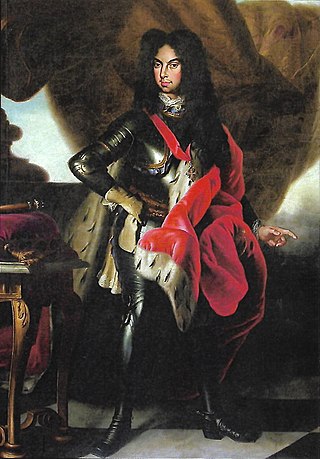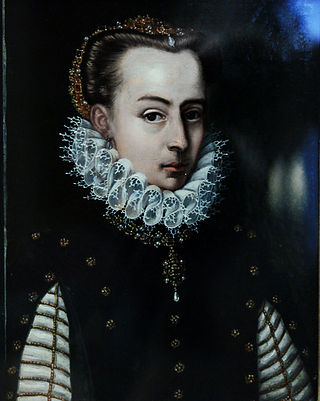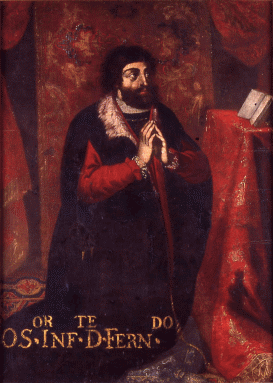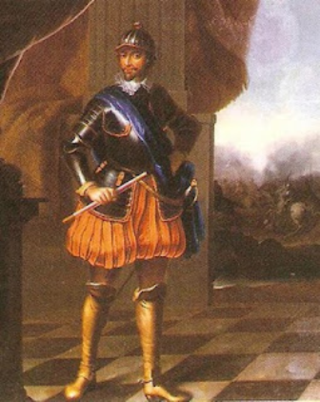
DomAfonso VI, known as "the Victorious", was the second king of Portugal of the House of Braganza from 1656 until his death. He was initially under the regency of his mother, Luisa de Guzmán, until 1662, when he removed her to a convent and took power with the help of his favourite, D. Luís de Vasconcelos e Sousa, 3rd Count of Castelo Melhor.

Manuel I, known as the Fortunate, was King of Portugal from 1495 to 1521. A member of the House of Aviz, Manuel was Duke of Beja and Viseu prior to succeeding his cousin, John II of Portugal, as monarch. Manuel ruled over a period of intensive expansion of the Portuguese Empire owing to the numerous Portuguese discoveries made during his reign. His sponsorship of Vasco da Gama led to the Portuguese discovery of the sea route to India in 1498, resulting in the creation of the Portuguese India Armadas, which guaranteed Portugal's monopoly on the spice trade. Manuel began the Portuguese colonization of the Americas and Portuguese India, and oversaw the establishment of a vast trade empire across Africa and Asia.

John II, called the Perfect Prince, was King of Portugal from 1481 until his death in 1495, and also for a brief time in 1477. He is known for re-establishing the power of the Portuguese monarchy, reinvigorating the Portuguese economy, and renewing his country's exploration of Africa and Asia.

DomPedro II, nicknamed "the Pacific", was King of Portugal from 1683 until his death, previously serving as regent for his brother Afonso VI from 1668 until his own accession. He was the fifth and last child of John IV and Luisa de Guzmán.

The Most Serene House of Braganza, also known as the Brigantine dynasty, is a dynasty of emperors, kings, princes, and dukes of Portuguese origin which reigned in Europe and the Americas.

Eleanor of Viseu was a Portuguese infanta (princess) and later queen consort of Portugal. She is considered one of her country's most notable queens consort and one of the only two who were not foreigners. To distinguish her from other infantas of the same name, she is commonly known as Eleanor of Viseu or Eleanor of Lancaster. In Portugal, she is known universally as Rainha Dona Leonor.
The Portuguese succession crisis of 1580 emerged as a result of the deaths of young King Sebastian I of Portugal in the Battle of Alcácer Quibir in 1578 and his successor and great-uncle Henry I in 1580. As Sebastian and Henry lacked immediate heirs, a dynastic crisis unfolded, marked by internal conflicts and external contenders vying for the Portuguese throne. Ultimately, Philip II of Spain succeeded Henry I as King of Portugal, uniting the Portuguese and Spanish Crowns in the Iberian Union. This personal union endured for 60 years, during which the Portuguese Empire faced decline and global challenges, notably the Dutch–Portuguese War.

Infanta Catherine of Portugal, Duchess of Braganza by marriage was a Portuguese infanta (princess) claimant to the throne during the Portuguese succession crisis of 1580.

Infante Ferdinand, Duke of Viseu and Beja was the third son of Edward, King of Portugal and his wife Eleanor of Aragon.

Jorge de Lencastre was a Portuguese prince, illegitimate son of King John II of Portugal and Ana de Mendonça, a lady-in-waiting to Joanna la Beltraneja. He was created the second Duke of Coimbra in 1509. He was also master of the Order of Santiago and administrator of the Order of Aviz from 1492 to 1550.

Infante Luís of Portugal, Duke of Beja was the second son of King Manuel I of Portugal and his second wife, Maria of Aragon. He participated in the Conquest of Tunis.

Luisa María Francisca de Guzmán y Sandoval was Queen of Portugal as the spouse of King John IV, the first Braganza ruler. She was the mother of two kings of Portugal and a queen of England. She served as regent of Portugal from 1656 until 1662.

Dona Maria Francisca Isabel of Savoy was Queen of Portugal during her marriage to King Dom Afonso VI from 2 August 1666 to 24 March 1668 and, as the wife of Afonso's brother King Dom Peter II, from 12 September 1683 until her death in December that year. She married Afonso VI at the age of 20; because the marriage was never consummated, she was able to obtain an annulment. On 28 March 1668, she married the King's brother Infante Dom Peter, Duke of Beja, who was appointed prince regent the same year due to Afonso's perceived incompetence. She became queen a second time when Afonso died and Peter succeeded his brother, but she herself died three months later.

Eleanor of Aragon was Queen of Portugal from 1433 to 1438 as the spouse of King Edward. After Edward's death, she served as regent in 1438-1440 for her son Afonso V. She was the daughter of Ferdinand I of Aragon and Eleanor of Alburquerque.

The Military Order of Saint James of the Sword is a Portuguese order of chivalry. Its full name is the Ancient, Most Noble and Enlightened Military Order of Saint James of the Sword, of the Scientific, Literary and Artistic Merit.

Dom Fernando II of Braganza was the 3rd Duke of Braganza and the 1st Duke of Guimarães, among other titles. He is known for being executed for treason against the King.
Constable of Portugal was an office created by King Ferdinand I of Portugal in 1382, to substitute the High Standard-bearer (Alferes-Mor) as the head of the Portuguese Military. It was also referred as the Constable of the Kingdom.

Duke of Viseu was a Portuguese Royal Dukedom created in 1415 by King John I of Portugal for his third male child, Henry the Navigator, following the conquest of Ceuta.

Infanta Beatriz of Portugal was a Portuguese infanta, daughter of John, Constable of Portugal, and Isabella of Barcelos, a daughter of Afonso I, Duke of Braganza.

Duke of Beja was an aristocratic Portuguese title and royal dukedom, associated with the Portuguese Royal House.




















